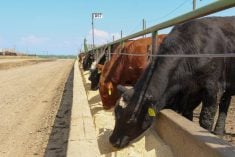During the second week of March, Alberta packers were buying fed cattle on a dressed basis in the range of $378-$380 per hundredweight (cwt) delivered.
Prices f.o.b. (free on board) the feedlot in southern Alberta were quoted from $225 to $226/cwt. The market has been consolidating over the past month, as market-ready fed cattle supplies remain burdensome.
Fed cattle basis levels in Alberta have been historically wide through the winter. In the U.S., packers have once again curtailed the slaughter pace during February and March. Cattle on feed 150 days or more are above year-ago levels.
Read Also

Managing through market or individual stock declines
Even the best of public-traded companies can periodically experience significant drawdowns, and a successful investor should be prepared to react — or not react — accordingly, Herman VanGenderen writes.
Looking forward, a year-over-year decrease in feeder cattle placements in both Canada and the U.S. during the first quarter will result in tighter market-ready supplies during the summer. Western Canadian feeder cattle markets continue to percolate higher. At the time of writing, backgrounded mixed steers weighing 875 pounds were trading at $320/cwt in southern Alberta while 500-lb. steer calves were quoted at $465/cwt in the same region.
The U.S. and Canadian calf crops have been contracting for the past few years. Canadian barley production is poised to increase in 2024. Finally, the stronger fed cattle outlook for the third quarter has bolstered buying interest for yearlings and calves.
U.S. cattle on feed for slaughter as of Feb. 1, 2024 were 11.797 million head, up nearly one per cent or 93,000 head from Feb. 1, 2023. The U.S. slaughter has run sharply below year-ago levels which has resulted in a backlog of market-ready fed cattle supplies.
Processed carcass weights have been coming in eight to nine pounds above year-ago levels. This situation will change later in May. U.S. feedlot placements from Nov. 1, 2023 through Jan. 31, 2024 were 5.364 million head, down 256,000 head from the the same period 12 months earlier. The year-over-year decline in placements will continue each month moving forward.

In the above table, you’ll see the U.S. Department of Agriculture’s quarterly beef production estimates. For the third quarter of 2024, USDA is projecting beef production to finish near 6.535 billion lbs., down only 86 million lbs. from last year.
However, our estimate is closer to 6.3 billion lbs., which would be down 300 million lbs. from the third quarter of 2023. We believe this will be a bullish surprise to the market during the summer timeframe.
In Western Canada, a similar supply situation has developed. Cattle on feed inventories in Alberta and Saskatchewan were similar to year-ago levels as of Feb. 1. Placements from November 2023 through January 2024 were 421,500 head, down 74,100 head from the same period a year earlier.
Cattle on feed supplies in Western Canada will drop sharply below year-ago levels during the summer months, resulting in a stronger fed cattle basis. The Alberta fed cattle market will need to trade at a premium to U.S. values to slow exports.
The feeder cattle market is also moving through a transition stage. U.S. corn acres are expected to be down five per cent from last year. Using a five-year average yield, production has potential to reach 363 million tonnes, down from the 2023 output of 390 million tonnes.
The reverse is occurring in Canadian barley production. Statistics Canada’s acreage survey had barley acres at 7.1 million, down 2.6 per cent from 2023. Using an average yield, production has potential to reach 9.8 million tonnes, up 900,000 tonnes from last year.
This is a bearish outlook for feed barley, but the corn market is bullish. Western Canadian feedlot operators will have the competitive advantage on feed grain costs in the 2024-25 crop year.
The feeder market will be influenced with stronger fed cattle prices and a bearish barley market for the latter half of 2024. Prices are at historical highs, but we’ll likely see another leg higher in the market during August and September. Canadian feeder cattle prices will be premium to U.S. values, thereby limiting feeder cattle exports.
The industry is bracing for significant heifer retention this fall. Prices for bred heifers and bred cows are up 30 per cent from three months ago. We believe there is further upside for bred cows, bred heifers and cow calf pairs. We discussed the market for herd replacements and cow-calf pairs earlier in January and the rally is now materializing.
In conclusion, U.S. beef production during the third quarter of 2024 is expected to be down 300 million lbs. from the third quarter of 2023. This will result in stronger fed cattle prices during July and August. Basis levels for Canadian feeder cattle will strengthen in the second and third quarters of 2024. Canadian barley production is expected to be up from last year, while U.S. corn output will be down from year-ago levels. We’re expecting significant heifer retention on both sides of the border thereby shrinking the available supply pool of feeder cattle.
















